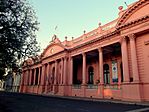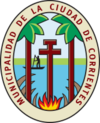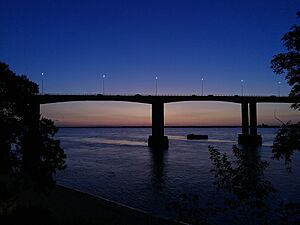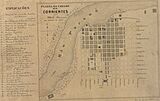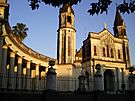Corrientes facts for kids
Quick facts for kids
Corrientes
|
|||
|---|---|---|---|
|
Above: Panorama view of Manuel Belgano Bridge, Corrientes Carnival on every February Middle:The city of Corrientes with the General Belgano Bridge in the background Bottom: Corrientes Carthedral, Corrientes City Hall (All items were left to right)
|
|||
|
|||
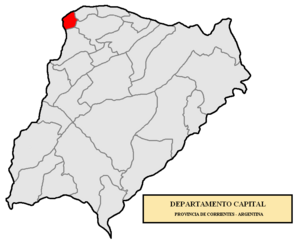 |
|||
| Country | |||
| Province | |||
| Department | Capital | ||
| Area | |||
| • City | 500 km2 (200 sq mi) | ||
| Elevation | 52 m (171 ft) | ||
| Population
(2010 census)
|
|||
| • Urban | 346,334 | ||
| Demonym(s) | Correntine correntino/a (Spanish) taraguigua (Guarani) |
||
| Time zone | UTC−3 (ART) | ||
| CPA base |
W3400
|
||
| Dialing code | +54 379 | ||
| Website | Official website: http://www.ciudaddecorrientes.gov.ar/ | ||
Corrientes (which means "Currents" in Guaraní) is the capital city of the Corrientes province in Argentina. It's located on the eastern side of the Paraná River. The city is about 1,000 kilometers (620 miles) from Buenos Aires.
Corrientes has a mix of old and new buildings. You can see many churches and beautiful trees like lapacho, ceibo, and jacaranda. It's also famous for its big carnival celebrations and traditional chamamé music. The average temperature here is around 21.3°C (70.3°F) each year.
Contents
Getting Around Corrientes
Corrientes is located in the Argentine Littoral region, close to the border with Paraguay. The General Belgrano Bridge connects Corrientes across the Paraná River to Resistencia, which is the capital of the neighboring Chaco Province.
Up the Paraná River, between Paraguay and Argentina, is the Yaciretá dam. This is one of the largest power plants in the world that uses water to create hydroelectricity.
The city also has an airport called Doctor Fernando Piragine Niveyro International Airport. It's about 5 kilometers (3 miles) from the city center.
Corrientes Through Time
The city of Corrientes was founded on April 3, 1588, by Juan Torres de Vera y Aragón. He first named it San Juan de Vera de las Siete Corrientes. This long name was later shortened to just Corrientes. The "seven currents" refer to seven areas along the river where the water flows very strongly, making it hard for boats to pass.
Corrientes became an important stop because of its location between Asunción (in modern-day Paraguay) and Buenos Aires. Its high ground, about 55 meters (180 feet) above the river, also helped protect it from floods.
In 1615, a group called the Jesuits settled near the Uruguay River. In 1807, the city bravely fought off British attacks. During the Argentine War of Independence, Corrientes often disagreed with the government in Buenos Aires. However, they united during the Paraguayan War after Paraguayan forces attacked the city in 1865.
What's the Weather Like?
Corrientes has a humid subtropical climate. This means it usually has warm, wet summers and mild winters. The average yearly temperature is about 21.4°C (70.5°F). The city gets around 1,455 millimeters (57 inches) of rain each year.
It rarely freezes in Corrientes. The coldest temperature ever recorded was -2.8°C (27°F) on June 15, 1979. The hottest temperature ever recorded was 43.5°C (110.3°F) on October 1, 2020.
Learning in Corrientes
Corrientes is home to several universities, including:
- National University of the Northeast
- University of Cuenca del Plata
Cities Around the World
Corrientes is connected to other cities around the world as "sister cities":
 Encarnación, Paraguay
Encarnación, Paraguay Estepa, Spain
Estepa, Spain
Corrientes in Stories
The Graham Greene spy novel The Honorary Consul (1973) takes place in Corrientes.
Sports in Corrientes
The main football (soccer) teams in the city are:
- Huracán Corrientes
- Boca Unidos
- Deportivo Mandiyú
Famous People from Corrientes
Many talented people come from Corrientes, including:
|
|
Gallery
See also
 In Spanish: Corrientes (ciudad) para niños
In Spanish: Corrientes (ciudad) para niños






